Arduino backup power supply
The simplest way to connect a emergency backup battery as you describe is by diode ORing. Both the power supply and the battery dump onto the internal power bus thru a diode. Arrange for the power supply to be a bit higher voltage than the battery, and all the current will come from it. For example, if you have a 9 V battery then a 12 V power supply would work fine, assuming that the internal power supply can run the arduino from this whole range of voltages. This is the easy part.
The hard part is occasionally testing the battery while it is not in use. The problem is that you don't want this to run down the battery. One strategy is to use a high resistance divider to get down to the arduino's A/D input range. You could make it high enough so that the little bit of current draw is small enough compared to the battery capacity so that it doesn't matter. However, then you end up with a very high impedence signal which is unsuitable for the A/D input on the processor. You would have to buffer it, which is doable, but adds some complexity.
Another option is to switch the battery tester circuit on when needed. That takes a extra processor output pin, but now you can switch in a more substantial load so that the signal is suitable for the A/D input directly, and also puts enough load on the battery to get a meaningful measurement. You want to load it with a few 10s of mA to see what it can do with a real load, not just sitting there without providing current. Here is one way to do this:

BATT_TEST is driven by a processor digital output. When low, the battery current is off. When high, the battery voltage minus the little saturation voltage of Q2 will be applied accross the R2-R3 divider. This divider brings the voltage into the processor's range, and also loads the battery at the same time. BATTV is suitable to connect directly to a processor A/D input. You only have to turn this on for a few 10s of µs to test the battery. Once a day should be plenty often enough to check a battery that is not being used. 50 mA or so once a day for 100 µs isn't going to impact the life of the battery.